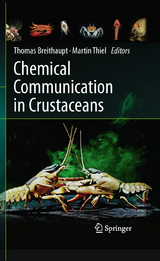Chemical Communication in Crustaceans
Springer-Verlag New York Inc.
978-0-387-77100-7 (ISBN)
The crustaceans are ecologically and economically important organisms. They constitute one of the dominant invertebrate groups on earth, particularly within the aquatic realm. Crustaceans include some of the preferred scientific model organism, profitable aquaculture specimen, but also invasive nuisance species threatening native animal communities throughout the world. Chemoreception is the most important sensory modality of crustaceans, acquiring important information about their environment and picking up the chemical signals that mediate communication with conspecifics.
Significant advances have been made in our understanding of crustacean chemical communication during the past decade. This includes knowledge about the identity, production, transfer, reception and behavioral function of chemical signals in selected crustacean groups. While it is well known that chemical communication is an integral part of the behavioral ecology of most living organisms, the intricate ways in which organisms allocate chemicals in communication remains enigmatic. How does the environment influence the evolution of chemical communication? What are the environmental cues that induce production or release of chemicals? How do individuals economize production and utilization of chemicals? What is the importance of molecule specificity or mix of a molecule cocktail in chemical communication? What is the role of chemical cues in multimodal communication? How does the ontogenetic stage, the sex or the physiological status of an individual affect its reaction to chemical cues? Many of these questions still represent important challenges to biologists.
Part I. Introductory Section: General Introduction. Pheromones and behaviour - overview, definitions.- Part II. General Overview of Signal Characteristics and Reception: Finding the mate: Pheromone hydrodynamics and odour acquisition. Orientation to pheromone sources in turbulent plumes. Functional morphology of chemoreceptors. Olfaction and pheromone reception in crustaceans. Processing of chemical information in the crustacean brain. Beyond crustaceans: The nature of communication chemicals: their solubility and volatility, stability and specificity. Pheromone communication in aquatic and aerial environments.- Part III. Chemical Communication and Behaviour: Chemical communication in lobsters. Chemical communication in crayfish. Chemical modulation of aggressive interactions in stomatopods. Alarm substance and predator avoidance in crustaceans. Chemical communication in shrimp. Chemical communication in peracarid crustaceans. Chemical communication in anomurans. Chemical communication in terrestrial crustaceans. Chemical communication in copepods. Beyond crustaceans: Honest signals or deceit – how reliable are pheromones? Chemical communication in a multi-modal context.- Part IV. Towards Identification of Chemical Signals: Identification of a sex pheromone in decapod crustaceans. Chemical communication and hormones. Settlement cues of barnacles. Beyond crustaceans: A review of pheromone communication in fish.- Part V. Applied Aspects: The use of pheromones in integrated pest managements (IPM). Environmental contamination and effects on chemical communication. Principles of crustacean farming: Problems and solutions.
| Erscheint lt. Verlag | 25.11.2010 |
|---|---|
| Zusatzinfo | XVIII, 565 p. |
| Verlagsort | New York, NY |
| Sprache | englisch |
| Maße | 155 x 235 mm |
| Themenwelt | Naturwissenschaften ► Biologie ► Ökologie / Naturschutz |
| Naturwissenschaften ► Biologie ► Zoologie | |
| ISBN-10 | 0-387-77100-X / 038777100X |
| ISBN-13 | 978-0-387-77100-7 / 9780387771007 |
| Zustand | Neuware |
| Haben Sie eine Frage zum Produkt? |
aus dem Bereich




